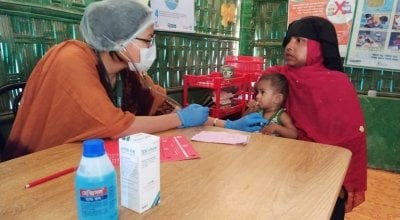
Knowledge Hub
No one should have to live with hunger and the damage it does - that’s why we're working for a world in which no one dies for want of safe, quality, nutritious food. But what causes hunger, and what are its impacts for the communities we’re working with?
Hunger: Key definitions
‘Hunger’: a physical discomfort as a result of chronic food shortage or, in severe cases, a life-threatening lack of food
‘World hunger’: hunger aggregated to the global level
‘Food insecurity’: limited or unreliable access to foods that are safe and nutritionally adequate
‘Malnutrition’: a condition resulting from insufficient intake of essential nutrients
Source: National Research Council, 2006
What causes hunger?
- Poverty
Poverty is caused by a lack of resources, unequal income distribution in the world, conflict and hunger itself, which can lead to even greater poverty by reducing people’s ability to work and learn.
- Conflict
Conflict can interfere with food and agriculture production and impact the economy, driving up food prices and making it difficult to buy necessary foods.
- Political instability
Political instability can affect a country’s economy, in turn reducing the value of a country’s currency - leading to higher food prices and less nutritious food available.
- Climate change
Unstable weather patterns can lead to drought and food insecurity, while hurricanes and cyclones can produce powerful storms that cause damage to agricultural production and market prices.
Source: https://www.worldhunger.org/world-hunger-and-poverty-facts-and-statistics/#causes1
What impacts can hunger have?
- Hunger can stop people developing a healthy immune system.
Good nutrition is the first line of defence against disease and is essential to developing a healthy immune system. But when mothers are forced to reduce the number of meals children eat, or families replace nutritious foods like vegetables and beans for staples like corn and millet, common infectious diseases can become killers. Without the right nutrients, children can’t grow up healthily, adults don’t have enough energy to work and people’s immune systems are weak.
- Hunger can force people to make tough choices that push them further into poverty.
Parents may take their children out of school to work, farming families might eat seeds that should be preserved for the next harvest. These choices make people at risk even more vulnerable. When disaster strikes, it’s the poorest communities – already exposed to hunger and disease – who suffer the most.
- Hunger can prevent communities from escaping poverty.
The long-term effects of hunger go beyond health. Poor nutrition leads to poor performance in school and fewer opportunities. Children’s brains will not fully develop and their bodies will be stunted. This has a devastating long-term effect on families, communities and countries.
Five facts about hunger
1. Hunger and malnutrition are greatest risks to health worldwide – every year they kill more people than AIDS, malaria and tuberculosis combined.
Source: https://www.un.org/en/
2. Right now, 821 million people do not have enough to eat and the vast majority of them live in developing countries. That’s one in 9 people going to bed on an empty stomach each night.
Source: http://www.fao.org/state-of-food-security-nutrition/en/
3. In 2019, the majority of people who suffered acute food insecurity lived in countries affected by conflict (77 million), climate change (34 million) and economic crises (24 million people).
Source: https://www.wfp.org/publications/2020-global-report-food-crises
4. The coronavirus pandemic could push 265 million people into acute food insecurity by the end of this year - almost double last year’s total.
Source: https://www.wfp.org/publications/2020-global-report-food-crises
5. 75 million children were stunted (too thin for average height) and 17 million suffered from wasting (too thin for average weight) due to hunger in 2019.
Source: https://www.wfp.org/publications/2020-global-report-food-crises
How is Concern tackling hunger?
For 50 years, we’ve been developing and delivering practical, intelligent, sustainable solutions to tackle hunger in the world’s poorest places - combining our expertise with local knowledge.
One way we respond is to support health and nutrition centres in some of the toughest-to-reach areas, and during times when hunger levels are at their worst.
Our pioneering Community Management of Acute Malnutrition (CMAM) approach funds clinics that provide essential maternal and childhood healthcare for severely malnourished babies and young children, giving children weekly medical treatment and therapeutic food. At the heart of this approach are volunteers in the community who actively screen children and pregnant and breastfeeding women for malnutrition.
Another approach is through our range of livelihood programmes. Across the globe, these programmes give people the tools to improve animal help and productivity, seeds and materials to build vegetable gardens at home or agricultural vouchers that enable farming households to buy tools and seeds that will increase their harvest. Each of these approaches give people opportunities to sell food at market, earn a living or grow their own food, increasing the quantity and variety of food they have access to.
The number of people battling acute hunger and suffering from malnutrition is on the rise – and the coronavirus pandemic could push even more families and communities into distress.
Join our campaign and get the UK government to act now to prevent a hunger crisis





